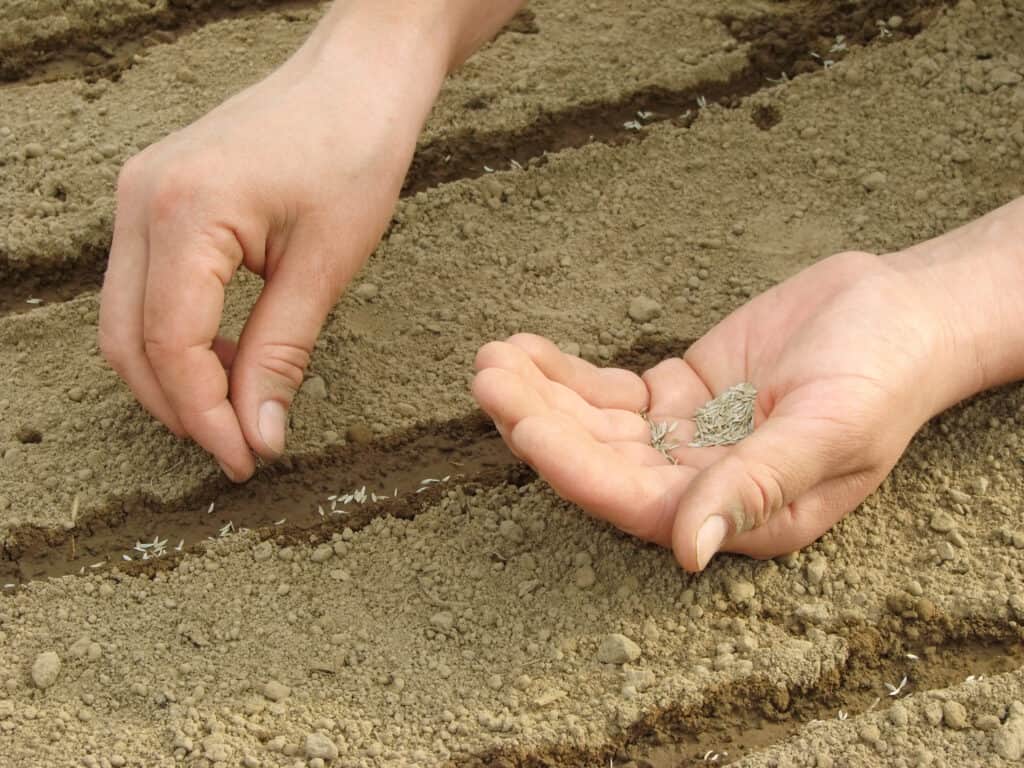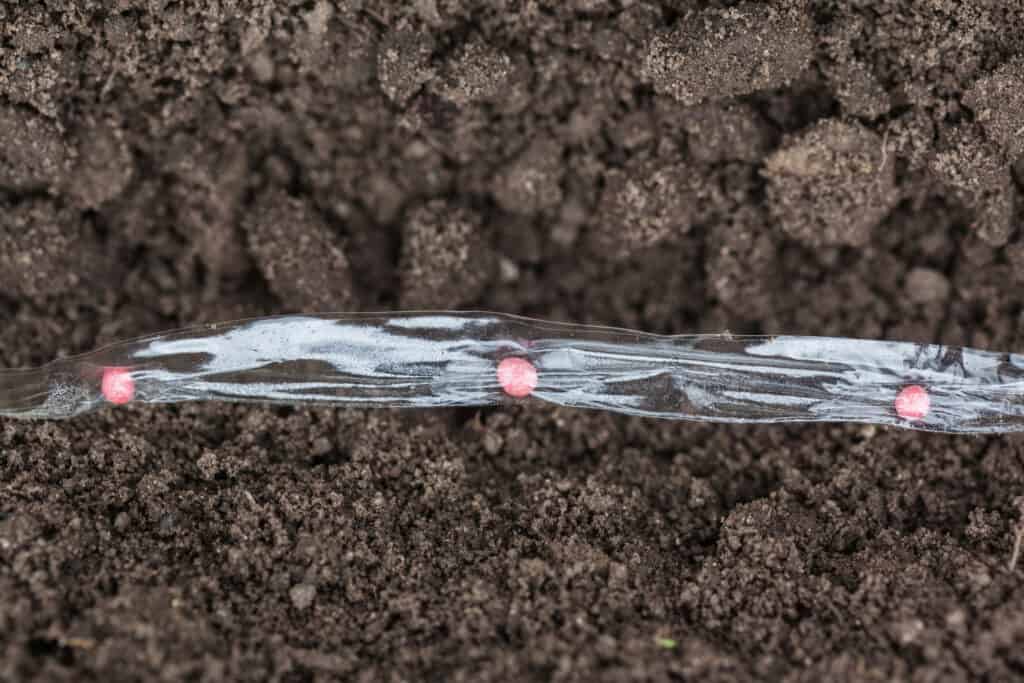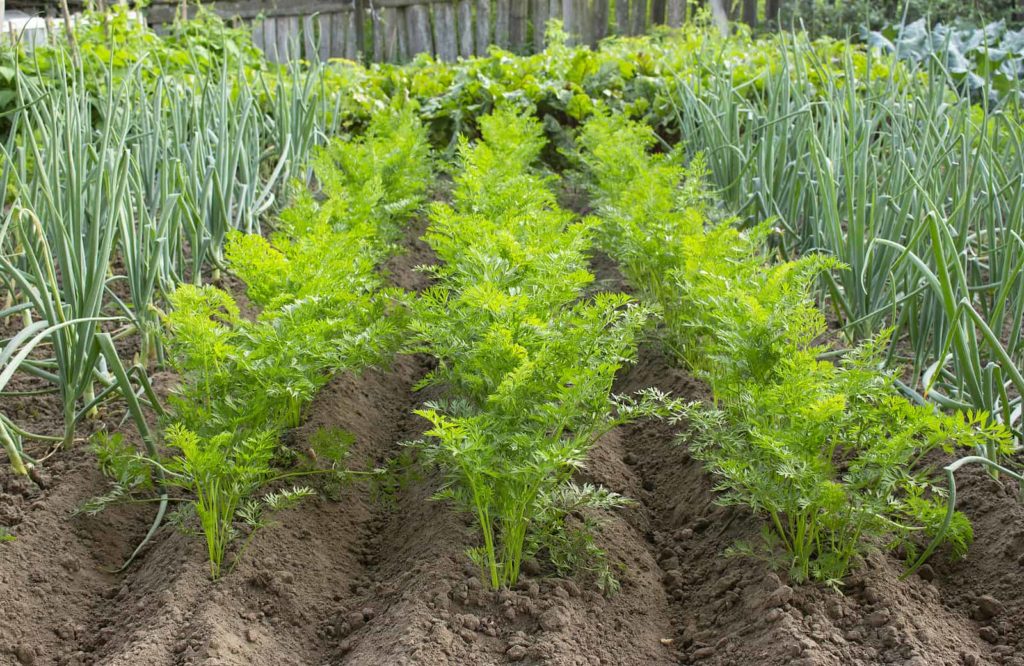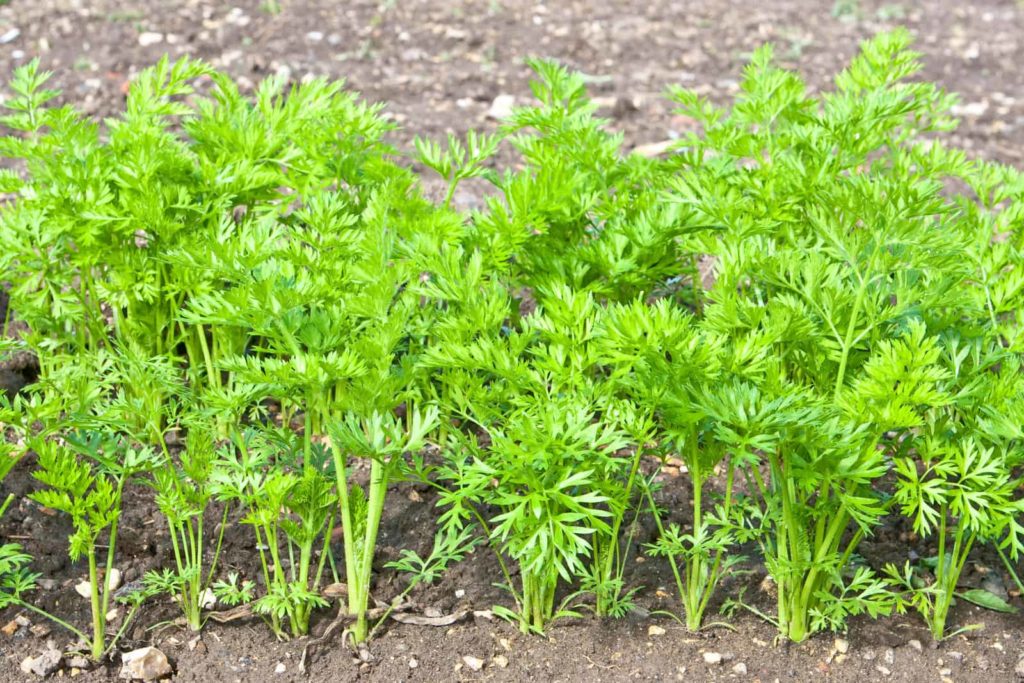Carrots are a cool-season crop; they are best grown in spring and fall. Carrots are commonly grown in spring, fall, and winter in warm-winter regions. Carrots can be grown through the summer in mild to cool summer regions and a surplus can be stored for winter.
Carrots may be seeded as early in spring as the ground can be worked. Make successive sowings of carrots at intervals of about 3 weeks in order to have a continuous supply of tender carrots throughout the season.
Grow carrots and other root crops in light-textured soil free of pebbles and stones. This will ensure roots do not split or become malformed. Carrots will grow on almost any type of soil as long as it is moist, humus-rich, loose, and free from clods and stones. Sandy loams and peats are the best.
Carrot articles at Harvest to Table:
Grow Carrots Any Time of the Year in Five Steps
How to Harvest and Store Carrots
Good Products for Growing Carrots at Amazon:
- Garden Safe Snail and Slug Bait
- Bonide Sulfur Fungicide
- Monterey BT Caterpillar Killer
- Neem Bliss 100-% Cold Pressed Neem Oil
- Safer Brand Insect Killing Soap
- PyGanic Botanical Insecticide
Cover carrot seed about ½ inch on moist soils; less, usually about ¼ inch, on heavy soils.
With care in seeding, carrots will require little thinning. Carrots can stand some crowding, especially in loose soils. However, carrots should grow no thicker than 10 to 15 plants per foot of row.
Standard carrots are Chantenay, Nantes, and Imperator.
Carrots should be harvested and stored before the first hard frost occurs; the roots may be injured by cold.

Plant carrots for winter harvest and storage in late spring or early summer when you plant tomatoes; they will mature in cooling autumn soil. Carrots that mature in cool soil are the most flavorful.
Quick-maturing carrots are a good choice for planting in spring; they will come to harvest before warm summer weather arrives.
There are many varieties of carrots to grow; miniature carrots have round or short blunt roots; some long-root varieties have blunt roots; some have long tapered roots. Carrots are always orange on the inside but the color outside can be orange, white, yellow, and even purple.
Carrots mature in 50 to 100 days depending on the variety.

Carrot planting details
- Sowing depth: ¼ -½ inch (.6-1.2cm)
- Space between plant after thinning: 1-3 inches (2.5-7cm)
- Days to sprout: 12
- Days to harvest: 70-85
- Storage period: 2-3 weeks
- Seeds per 100-row feet: ½ ounce (14g)
- Yield per 100-row feet: 100 pounds (45 kilos)
- Suggested Varieties: Chantenay, Nantes, Imperator, Touchon
- Notes: Store where not too dry
Carrot sowing and planting tips
- Carrot seed is viable for 3 years.
- Direct-sow carrot seed in the garden 4 to 2 weeks before the last spring frost; moisten the soil before planting so that the tiny, light seeds do not blow away.
- Lay the seed on the seedbed then cover it with ¼ inch of fine soil; then sprinkle the soil gently with a fine spray of water trying as best you can to avoid disturbing the seed. Cover the seed with no more than ½ inch (1 cm) of fine, loose soil.
- Sow seeds 2 inches (5 cm) apart or plan to thin seedlings 2 to 3 inches apart.
- Planting carrots on a raised row is a good way to know exactly where you’ve planted; rake loose soil into a raised 8-inch wide mound and then sow atop the raised flattened row and cover with soil.
- Space rows 6 to 8 inches (15-20 cm) apart; space 3 rows in a 30-inch-wide (0.75cm) bed and 4 rows in a 36-inch (0.9m) bed.
- Perhaps the easiest way to not over-sow is to simply and carefully sow just one or two seeds at a time; this will take time, but you will likely not need to thin seedlings later.
- Keep the soil evenly moist until the seeds germinate. Avoid creating crusted soil; carrot seeds will struggle to emerge through crusted soil.
- Germination will come in about 6 days if the soil temperature is at or near 75°F (24°C)—but sometimes seeds can take up to 3 weeks to germinate if the soil is cold. Germination will not occur in soil chillier than 45°F (7°C).
- A good time to sow carrots is about the time you sow pole beans or set out tomato transplants.
- It’s easy to over-sow carrot seeds; to avoid over-seeding mix seed with sand, vermiculite, or dry used coffee grounds—that way you can see where you sow. Pelleted carrot seeds or seed tapes are an even easier way to sow carrots.
- If started indoors and transplanted out, allow carrots two additional weeks to maturity as a result of root insult at transplanting; nip off the long thread tip of the carrot root when transplanting.
- To improve germination sow seed at dusk or on a cool, cloudy day.
- Add aged compost to planting beds in advance of sowing; compost will feed the soil and aid moisture retention.
- Make additional sowings at 3-week intervals for a continuous harvest, but time your seed sowing so that crops do not mature in hot weather.
- Carrots grow best when daytime temperatures are in the 60s°F.
- Carrots prefer a pH range of at least 5.5 to 6.5, optimal above 6.0.
- Grow carrots in full sun for best yield; carrots tolerate partial shade.
- Avoid planting carrots where celery, dill, fennel, parsley, or parsnips have grown recently.
- Fertilize with an organic fertilizer such as fish emulsion at half strength.
- Carrots don’t have significant pest problems, but young carrots will suffer if forced to compete with weeds. Carrot flies can attack maturing carrots; carrot flies are repelled by sage and scorzonera.
How to pre-sprout carrot seeds
Carrots and other carrot family crops such as parsley and parsnips can be slow to germinate. They require consistently moist soil and sometimes two weeks or more for germination. Dry or windy weather can mean slow or no germination for carrots.
Pre-sprouting is the best way to short-cut carrot germination time and ensure a crop; there is no guessing whether the seedbed has accidentally gone dry and delayed or derailed your crop.
Here are two ways to pre-sprout carrots seeds:
Boiling water method
- Sprinkle seed across a tray of sterile potting soil or seed starting mix (you can also use aged compost, and sand or vermiculite).
- Pour very warm or just boiling water over the seed. Boiling water removes the cuticle and some lower epidermal layers of carrot seed hulls.
- Cover the seeds with potting soil or seed starting mix and place the tray inside a clear plastic bag.
- Mist the soil with a kitchen spray bottle twice a day until the seed has sprouted.
Freezing method
- Mix the seed with damp potting soil or seed-starting mix; spread the mix across a seed-starting tray or paper plate.
- Place the tray or plate in a clear plastic bag, seal it, and set it in the freezer for twenty-four hours but not longer. (This is called cold stratification; placing the seed in the freezer for twenty-four hours is enough for the seed to think it has gone through a winter, but not long enough to freeze and damage cells inside the seed.)
- Then place the seed and soil mix—still inside the plastic bag (use a large zip lock bag for a paper plate)—on a seed-starting heat mat or refrigerator top or another appliance top at 70° to 80°F for three days or longer—until the seed sprouts.
What to do when seeds sprout
- Once seeds sprout, take them out of the plastic bag and gently set the sprouts in prepared rows and furrows ¼-inch deep then cover them lightly with potting soil.
- Keep the new sprouts well watered until they are rooted and growing.
Pre-sprouting results
- The sprouts will grow uniform in height and produce a crop two weeks earlier than if you had sown seed directly in the planting bed.
- Most carrot varieties take 70 to 80 days from sowing to harvest. The best time to grow carrots is in the cool times of the year—spring or fall.
- Fall grown carrots can be stored in the garden bed until you are ready to use them—as long as the soil does not freeze.
About carrot and carrot family seeds
- Carrots, parsnips, and parsley take 14 to 21 days to germinate; that means you must keep the seedbed evenly moist for up to three weeks or longer. This may require near-constant attention.
- Carrots and carrot family crops are slow to germinate because they have hard seed coats (seed coats or hulls protect seed embryos from decay and deterioration).
- For seeds to germinate and begin growing moisture must penetrate the seed coat and activate an enzyme triggering respiration and plant cell duplication and growth.
- Both heat and cold can speed up a seed’s intake of moisture.
More carrot growing details at How to Grow Carrots.

Interplanting: Interplant carrots with English peas, lettuce, members of the onion family, tomatoes, sage, and rosemary.
Container Growing Carrots: Choose a container at least 10-12 inches (25-30) wide and deep.
Carrot planting calendar
Spring planting carrots for spring and summer harvest:
- 10-12 weeks before the last frost in spring: direct-sow in a plastic tunnel or cold frame for a spring harvest.
- 2-4 weeks before the last frost in spring: direct-sow in the garden if the minimum soil temperature is 40°
- Every 10 days sow succession crops; time last harvest before the summer heat.
Planting carrots for fall and winter harvest:
- 12-10 weeks before the first frost in fall: direct-sow in the garden for fall and winter harvest.
- 12-8 weeks before the first frost in fall: direct-sow in a plastic tunnel or cold frame for fall and winter harvest; when freezing weather arrives put a layer of leaves of straw covered with a floating row cover over the crop; uncover roots in winter as needed.
Planting dates for spring and summer harvest
(These dates are for the Northern Hemisphere)
| Average date of the last frost | Planting dates |
| Jan. 30 | Jan. 1-Mar.1 |
| Feb. 8 | Jan. 1-Mar.1 |
| Feb. 18 | Jan. 15-Mar.1 |
| Feb. 28 | Feb. 1-Mar. 1 |
| Mar. 10 | Feb. 10-Mar. 15 |
| Mar. 20 | Feb. 15-Mar. 20 |
| Mar. 30 | Mar. 1-Apr. 10 |
| Apr. 10 | Mar. 10-Apr. 20 |
| Apr. 20 | Apr. 1- May 15 |
| Apr. 30 | Apr. 10-June 1 |
| May 10 | Apr. 20-June 15 |
| May 20 | May 1-June 1 |
| May 30 | May 1-June 1 |
| June 10 | May 10-June 1 |
| June 10 | May 20-June 1 |

Recommended carrot types and varieties
- Baby carrots or Mini carrots are small carrots with a range of shapes, usually round or blunt—baby carrot varieties include ‘Amsdor’, ‘Minicore’, ‘Parmex’, and ‘Thumbelina’.
- ‘Chantenay’ is a group of all-purpose carrots—varieties include ‘Chantenay Imperial’, ‘Chantenay Red-Cored’, and ‘Chantenay Royal’.
- ‘Danvers’ is a group of carrots similar to ‘Chantenay’ but with longer roots—varieties include ‘Danvers Half-Long’, and ‘Danvers Red-Cored’.
- ‘Nantes’ is sweet and crisp, cylindrical and blunt-tipped—varieties including ‘Bolero’, ‘Mokum’, ‘Napoli’, ‘Nelson’, ‘Sweetness II’, and ‘Scarlet Nantes’.
- ‘Imperator’ is a group of long, taper-rooted carrots—they are less flavorful than many other carrots.
Botanical Name: Daucus carota var. sativus
Carrots are a member of the Apiaceae also called the Umbelliferae family, other members of this family include celery, dill, fennel, parsley, and parsnips.
Carrot articles at Harvest to Table:
Grow Carrots Any Time of the Year in Five Steps
How to Harvest and Store Carrots
Carrot and Parsnip Growing Problems: Troubleshooting
Seven Ways to Cook and Serve Carrots
Baby Beets, Baby Carrots, and Snap Peas Salad
Garden Planning Books at Amazon:
- Tomato Grower’s Answer Book
- Vegetable Garden Almanac & Planner
- Kitchen Garden Grower’s Guide Vegetable Encyclopedia
- Vegetable Garden Grower’s Guide















